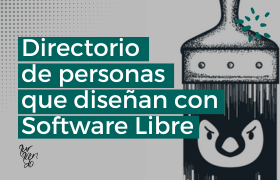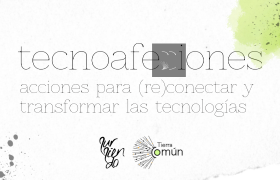Technology for life: Resistance from Indigenous and urban communities in Mexico

By Paola Ricaurte Quijano y Jes Ciacci
Tecnológico de Monterrey/Berkman Klein Center for Internet & Society, Sursiendo
Publish in GisWatch
Introduction
The pandemic caused by the COVID-19 virus has made environmental impact a close and daily experience for every person on the planet. On the one hand, it makes the destruction of biodiversity and the toll this takes on us visible. On the other hand, it demonstrates our deep interconnection: what affects one of us, affects us all. For this reason, we believe this is not only a health crisis, but a crisis for civilisation: a model for the world that is not sustainable and which can no longer be supported.
In this report, we argue that some of the deeply rooted conceptions of the West, promoted by financial organisations and international cooperation, such as the idea of industrial progress, modernity or development, are narratives constructed to justify the exploitation of the planet. We uphold that the discourses that promote the growth of the economy, production and consumption, contribute to the destruction of natural and social environments. Current development models promoted by international organisations serve to legitimise the extraction of resources from the global South. These models take advantage of cheap labour in the global South, reinforce its economic dependence on the global North and also make countries in the global South pay the human and environmental costs of sustaining the models.
The intensification of inequalities and the breakdown of community networks as a policy
Mexico is a country with deep social inequalities that are reflected at the infrastructure level, including in access to and use and appropriation of technologies related to the internet. The public policies of the Mexican state reproduce the global trend to deploy corporate technologies that reinforce digital colonialism. These policies conflict with communities that promote a relationship with technology that follows their traditions and conceptions of the world, and involves the defence of their labour rights and territory. It will be difficult to undertake a technological project that benefits marginalised communities and incorporates a sustainable vision of the future, as long as the policies keep ignoring social reality: multiculturalism, inequality, structural violence and institutional weakness. The challenge of information and communications technology (ICT) policies in Mexico involves resolving the tension between global forces and local needs. Resolving this tension also implies redefining infrastructure and access indexes. A document of recommendations from the Advisory Council of the Federal Telecommunications Institute stresses:
Connectivity and the services derived from it cannot be used to their full potential for economic, cultural and social development, while policies, regulations and people do not link their use and appropriation to the improvement of their quality of life and that of their community.
The Mexican government’s access initiatives demonstrate a lack of understanding of the social and environmental consequences of providing technological infrastructure through corporate solutions. The centre-left President Andrés Manuel López Obrador has engaged in conversations with Facebook and Microsoft, asking the companies to contribute to solving national access problems. In a teleconference with Facebook’s Mark Zuckerberg, the Mexican president expressed:
We care very much about your support, sharing this project. […] If you consider it interesting, we invite you to participate in creating a partnership. It would be something extraordinary if Facebook helped communication, connectivity in Mexico, especially for the benefit of the poor.[2]
In this sense, civil society expresses the urgency to support “local initiatives that can perfectly solve the problem of bringing the internet to non-connected areas.”[3] On the other hand, we need to articulate these initiatives with local proposals that carry out actions to reduce the negative impact of technologies on the environment. Different initiatives, both locally and at the public policy level, address the lack of participatory mechanisms in decision making, and the imposition of neoliberal measures to solve the problems created by them. Recognising the connection between land struggles and techno-resistance can enhance the construction of sustainable technological futures.
Mexican communities building other worlds
Based on a case study of different community initiatives in Mexico, we argue that the adverse environmental impact caused by the technology industry is much broader because it involves the destruction of the communities that inhabit the territories where they operate. The first case is the Coalition of Former Women and Men Workers and Workers of the National Electronic Industry (CETIEN), which shows us how colonial and capitalist development violate both labour rights and territory. The second case is that of the defenders of the territory against mining extractivism, the Popular Front in Defence of Soconusco (FPDS), in the southern region of Mexico. Some of the minerals extracted in the area are those used in the technology industry. The third is the case of the struggle of Indigenous communities in Oaxaca against the Mexican state for the right to Indigenous and community media and telecommunications.
Resistance to the production model
CETIEN is a coalition of electronic maquila workers in Jalisco, where the Ocotlán El Salto Industrial Corridor is located. For years it has denounced the effects of the technology industry on health and the environment. The organisation promotes coordination with community organisations for territorial defence. They recently explained how the environmental devastation in the area has contributed to worsening the health emergency caused by COVID-19.[4] Chemical, agro-industrial and technological corporations such as Celanes, Hutsman, IBM, HP and Sanmina are exploiting the area where the Santiago River and Lake Chapala are found, generating risks to safety and health due to the toxic substances they pour into the environment.
CETIEN documented how the companies in the electronic sector in the industrial corridor continued their production at the outbreak of COVID-19 in Mexico, despite the government calling for them to stop all non-essential activities, thereby threatening the health and well-being of women and men workers. For example, the US-based electronic company Sanmina, in which more than 20,000 people work, continued its activities, which means that in addition to exposing workers to contagion, it continued to contaminate the Santiago River basin with chemical waste. CETIEN also revealed that the company Benchmark Electronics, which likewise continued production, reported coronavirus cases among its workforce. CETIEN found that 78% of the victims of coronavirus are concentrated in areas with greater environmental contamination, such as the Santiago River polygon.
Resistance to the extraction model
The technologies we use contain large amounts of minerals. For instance, to produce a cellphone, about 200 different types of minerals are necessary. Some minerals such as titanium, copper, silver and gold are found in the state of Chiapas, in southern Mexico, where nearly 20% of the territory is compromised by mining activities. As of September 2019, the Secretary of the Economy had 140 open pit mines registered,[5] with exploitation permits that run until 2060. Open pit mines use a lot of water: “A small mine consumes around 250,000 litres of water per hour, while a large mine goes from one million to three million litres in the same period.”[6]
The municipalities of Escuintla and Acacoyagua are located within the state of Chiapas. Titanium is extracted from this area. A doctor from the town of Los Cacaos in Acacoyagua offers his testimony on the effects of the mining:
We know that this stone, apart from containing silica, contains quartz, titanium, uranium, it has chromium and releases gamma rays and alpha particles […]. Whether it is stored or whether it is bulk, how much radioactivity does it contain? We don’t know how many rays it is emitting at any given time; the point is that four people have died of liver cancer. And for a community of a thousand inhabitants it is too much. Why did such a problem not exist before?[7]
Under these circumstances, inhabitants of the region organised around the Popular Front in Defence of Soconusco (FPDS), a peaceful movement, born in mid-2015 to protect the Soconusco region in the coastal area of Chiapas – one of the most biodiverse regions in Mexico. Since then, they have maintained a blockade to prevent access by mining companies to the communities.
Both the national and state governments have ignored their claims concerning the environmental impact and health problems they are experiencing. A local resident declares that “the advance of the mining companies represents a setback for the food sovereignty of the communities.”[8] Therefore, as part of their resistance, in 2016 the communities declared themselves a mining-free municipality through a communal assembly act, a legal mechanism for the country’s ejido communities.[9]
In its years of resistance, the movement has been criminalised on several occasions. During the pandemic, actions to defend the territory have not stopped and the mining company, together with the local government, has intimidated residents, threatening to apply the «rule of law» to guarantee that the company can mine titanium.[10]
Resistance to the state’s model of territory
The Mixe community of Ttlahuitoltepec in Oaxaca is also resisting mining projects. Jënpoj Community Radio, an Indigenous communication project in the Ayuujk language, was set up 18 years ago.[11] Lilia Pérez, a community leader, shares the vision of her people:
In the territory we inhabit are our brothers and sisters who are living things: plants, animals, stones. […] When we decided to set up a radio and they told us that we had to ask permission to be on air, from our thinking we had to ask permission to the mountain and the ancestors, not from the state. […] But the new laws have made it that now the territory that belongs to us is only the soil; the subsoil belongs to the state, and the air too.
The idea of territory for the Indigenous and community populations of Mexico and their need for self-determination is not compatible with state laws. However, in practice, many of these populations have defended their collective right to communication and technological autonomy despite these impositions. The tradition of community radio in the country was followed years later by community telephone networks and, more recently, by community wireless networks.
In Mexico, 23% of the Indigenous population is disconnected.[12] Given the lack of the internet or its high cost, Indigenous peoples have used their inventiveness to build wireless networks that allow them to distribute the internet in their community or neighbouring communities. Through collaborative systems, new networks under other principles and values contribute to the creation of a new internet.
Examples of these initiatives are the Community Indigenous Telecommunications (TIC A.C.) telephone service in Indigenous communities of Oaxaca[13] and the Ik’ta K’op Collective wireless network in Chiapas.[14]
In July 2016, TIC A.C., with the support of Redes A.C.[15] and together with 16 Indigenous communities of Oaxaca, obtained the first Indigenous social concession in the history of Mexico to manage and operate autonomous telecommunications and broadcasting networks, including cellular telephony. However, upon obtaining the concession, the regulatory body, the Federal Telecommunications Institute, determined that they must abide by the resolution that forced them to pay for spectrum use as concessionaires, even though the network did not have a commercial purpose.[16] In November 2017, the court denied the request for exemption, but in March 2018, the Federal Judicial Branch granted them an amparo[17] that set a historical precedent, granting the right to develop community and Indigenous networks.
Conclusion
These cases show us the costs of the dominant model of technological development in communities and territories. They also show that the global North has direct responsibility for the damages generated in the territories of the global South. The state needs to generate projects that protect the self-determination of communities and their territories. The Mexican state, by not creating conditions for community and Indigenous networks to be sustainable, also undermines the possibility of developing technologies that are local and community-based, and which have less environmental impact. We observe, therefore, two forms of colonialism: a digital colonialism that is imposed from the West on territories of the global South, and an internal colonialism, promoted by governments that are accomplices to extractivist activities.
The current conception of technologies, centred on capitalist, patriarchal and colonial models, shows the biases and inequalities embedded in the process of design, production, use and disposal of technologies. In this report, we wanted to emphasise the complexity of the problem and insist that we require technologies that consider life above profit.
The deliberate fragmented vision of reality created by the capitalist model means that the hidden impact of technology is disconnected from the products that we use every day. The dichotomies of urban/rural, development/underdevelopment, inclusion/exclusion frequently found in Western narratives, do not recognise the various forms of existence in local territories. The idea of Western modernity imposes an unsustainable technological development model and reproduces colonial relationships in which the territories and people affected do not matter. In Indigenous and some peasant worldviews, nature and other living creatures are part of the same being. We maintain that when we do not conceive ourselves as part of nature and connected to other living beings, transformations will not be possible. Therefore, we require a technological development model that starts with the notion of mutual care and co-responsibility.
The global South should not continue to be the sink for the “needs” of the global North. This implies making it clear that the groups and individuals involved in the design, development, use and disposal of technologies have very different levels of responsibility in relation to the stage of the current crisis. Different lifestyles, privileges and colonial structures provide unequal frameworks of action for each participating social group. It is necessary to direct ourselves to forms of economy and society that are different from capitalism and put the very lives of people and their communities at the centre.
Action steps
The following steps are necessary:
- Carry out campaigns and actions that promote the reduction of consumption and the right to repair.
- Strengthen the creation and sharing of local and community technologies that meet the needs of the communities themselves.
- Promote spaces of social organisation between affected communities in the mining territories and workers from the tech industry. Share experiences of resistance and build common goals.
- Advocate for legislation that protects collective rights and territories, and which prevents and repairs the damage caused by technology companies.
- Consider guidelines for the deployment of technology in the territories that include indicators for a broad and integrated vision that is meaningful for local communities.
- Advocate for regional regulations that control the production and disposal of technology.
Footnotes
[1] III Advisory Council of the Federal Telecommunications Institute. (2018). Proposal for an indicator to measure the impact of the Internet and telecommunications on the quality of life of the Mexican population. https://consejoconsultivo.ift.org.mx [2] El Economista. (2019, 18 June). López Obrador invita a Mark Zuckerberg a llevar Internet a todo México con Facebook. El Economista. https://www.eleconomista.com.mx/arteseideas/Lopez-Obrador-invita-a-Mark-Zuckerberg-a-llevar-Internet-a-todo-Mexico-con-Facebook-20190618-0076.html. [3] Sursiendo. (2019, 19 June). Facebook requerido para salvar México es una mala noticia. Sursiendo, Comunicación y Cultura Digital. https://sursiendo.org/blog/2019/06/facebook-mexico-mala-noticia [4] Coalición Electrónica. (2020, 3 July). Vive Jalisco doble emergencia sanitaria: por el COVID-19 y por la devastación ambiental provacada por el modelo de producción. CETIEN Mexico. https://cetienmexico.wordpress.com/2020/07/03/vive-jalisco-doble-emergencia-sanitaria-por-el-covid-19-y-por-la-devastacion-ambiental-provacada-por-el-modelo-de-produccion [5] Domínguez, A. (2019, 1 September). Los conflictos futuros de Chiapas por la defensa del territorio. Chiapas Paralelo. https://www.chiapasparalelo.com/noticias/chiapas/2019/09/los-conflictos-futuros-de-chiapas-por-la-defensa-del-territorio [6] Martínez García, M. A. (2015, 10 February). Minería pone en riesgo a áreas naturales protegidas: Gustavo Castro. Americas Program. https://www.americas.org/es/mineria-pone-en-riesgo-a-areas-naturales-protegidas-gustavo-castro [7] https://www.youtube.com/watch?v=oUAPfGnh7-0 [8] Mandujano, I. (2017, 30 March). Chiapas: exigen a alcaldes de Escuintla y Acacoyagua frenar expansión minera en la zona. Proceso. https://www.proceso.com.mx/480291/chiapas-exigen-a-alcaldes-escuintla-acacoyagua-frenar-expansion-minera-en-la-zona [9] https://en.wikipedia.org/wiki/Ejido [10] Navarro, S. (2020, 25 March). México: En plena contingencia del Covid-19, gobierno intimida a ambientalistas para dar paso a la explotación de Titanio. Movimiento Mesoamericano contra el Modelo extractivo Minero. https://movimientom4.org/2020/03/mexico-en-plena-contingencia-del-covid-19-gobierno-intimida-a-ambientalistas-para-dar-paso-a-la-explotacion-de-titanio [11] Gayou Soto, S. (2019, 17 July). México: Radio Comunitaria Jënpoj, un espacio para la defensa del territorio. Medio a Medio. https://www.agenciadenoticias.org/mexico-radio-comunitaria-jenpoj-un-espacio-para-la-defensa-del-territorio [12] Olvera, D. (2018, November 16). Menospreciados por Movistar, Telcel y AT&T, pueblos indígenas crean una red propia, más barata. Sin Embargo. https://www.sinembargo.mx/16-11-2018/3494112 [13] TIC A.C. is a civil association made up of Indigenous and rural communities in Mexico and an operational team. This NGO accompanies individuals and communities seeking to build, manage and operate their own communication networks. Among its principles are “to provide tools in the field of telecommunications that favour the organisation for and among populations, the defence of territory, gender equality and the processes of autonomy and self determination.” https://www.tic-ac.org [14] http://www.iktakop.org [15] Redes por la Diversidad, Equidad y Sustentabilidad A.C. (Networks for Diversity, Equity and Sustainability) is a community organisation that has promoted public policies and reforms that make concessions possible to operate community networks and media. It promotes the production of situated and collective knowledge based on its experience of technological autonomy and supports the development of infrastructure. https://www.redesac.org.mx/derechos [16] Sin Embargo. (2017, 18 December). Indígenas pagan 40 pesos al mes en su red celular. Al IFT ya no le gustó: exige 1 millón, o les cierra. Noroeste. https://www.noroeste.com.mx/publicaciones/view/indigenas-pagan-40-pesos-al-mes-en-su-red-celular-al-ift-ya-no-le-gusto-exige-1-millon-o-les-cierra-1111134 [17] The writ of amparo is a remedy for the protection of constitutional rights. Salazar, G. (2018, 24 April). Telecomunicaciones Indígenas Comunitarias seguirá operando, pero aún hay camino por recorrer. Global Voices. https://es.globalvoices.org/2018/04/24/telecomunicaciones-indigenas-comunitarias-seguira-operando-pero-aun-hay-camino-por-recorrerNotes:
This report was originally published as part of a larger compilation: “Global Information Society Watch 2020: Technology, the environment and a sustainable world: Responses from the global South»
Creative Commons Attribution 4.0 International (CC BY 4.0) – Some rights reserved.
ISBN 978-92-95113-40-4
APC Serial: APC-202104-CIPP-R-EN-DIGITAL-330
ISBN 978-92-95113-41-1
APC Serial: APC-202104-CIPP-R-EN-P-331




